Numerical Study of the Toughness of Complex Metal Matrix Composite Topologies
Abstract
:1. Introduction
2. Topological Structures of Reinforcement
3. Materials and Methods
3.1. Theory on the Determination of the Fracture Toughness
3.2. CAD of the Topologies
3.3. Materials
3.4. Discrete Elements Method
3.4.1. Principle
3.4.2. Beams’ Properties Calibration
3.4.3. Model Design
3.4.4. Validation of the DEM Model
4. Results and Discussion
5. Conclusions
- Since a homogeneous MS-TiC structure has poor mechanical properties, the use of a shaped MS-TiC structure increases the damage resistance by 600% according to the simulation.
- The fineness of the DEM model makes it possible to calculate a macroscopic from simulations. The microscopic-macroscopic passage is validated with an error less than 10%. The microscopic constitutive relations were validated experimentally for a homogeneous MMC material.
- Concerning the topological structures, the FBCCZ structure with Y-orientation cell (FBCCZ_03) performs better, it absorbs the most energy and has the highest crack opening load. This structure absorbs more energy than the studied steel for a nearly equivalent failure stress.
- Regarding the crack path obtained by the DEM method, the crack generated during the tests tends to follow the contour of the reinforcing structures and seems to cause a decohesion at the insert/matrix interface. The trajectory deviation of the crack in gyroids is less abrupt than in micro-lattice structures because of its smoother curvature. The orientation of the struts is thus important in the crack propagation. There is an influence of the cell orientation on the fracture behavior of the structure.
Author Contributions
Funding
Conflicts of Interest
Nomenclature
| Abbreviations | ||
| BPEM | Bonded Particle Element Method | |
| CMOD | Crack Mouth Opening Displacement | |
| CT | Compact Tension | |
| DEM | Discrete Elements Method | |
| FBCCZ | Face and Body Centered Cubic with Z-truss | |
| FEM | Finite Element Method | |
| LEM | Lattice Element Method | |
| MMC | Metal Matrix Composite | |
| MS | Martensitic Steel | |
| MS-TiC | Martensitic Steel and Titanium Carbides | |
| CT parameters | ||
| Initial crack length | (mm) | |
| Length of the uncracked part of the CT specimen | (mm) | |
| Stress intensity factor coefficient | (no unit) | |
| l | Total height of the CT specimen | (mm) |
| B | Thickness of the CT specimen | (mm) |
| Fracture toughness | () | |
| Stress intensity factor | () | |
| L | Width of the CT specimen | (mm) |
| P | Load | () |
| Load at the intersection between the load-displacement curve and | () | |
| the 5∘ secant line | ||
| Maximum load of the load-displacement curve | () | |
| Critical load | () | |
| Yield strength | (MPa) | |
| W | Length from the bottom of the CT specimen to the center of its holes | (mm) |
| DEM parameters | ||
| Displacement in the loading direction during a compression test on | (mm) | |
| a cylindrical DEM domain | ||
| Displacement in the transverse direction during a compression test | (mm) | |
| on a cylindrical DEM domain | ||
| Length of a cylindrical DEM domain | (mm) | |
| Radius of a cylindrical DEM domain | (mm) | |
| Radius ratio of the bonds | (no unit) | |
| Elastic modulus of the bonds | (GPa) | |
| Failure stress of the bonds | (GPa) | |
References
- Singh, J.; Chauhan, A. Overview of wear performance of aluminium matrix composites reinforced with ceramic materials under the influence of controllable variables. Ceram. Int. 2016, 42, 56–81. [Google Scholar] [CrossRef]
- Das, D.K.; Mishra, P.C.; Singh, S.; Thakur, R.K. Properties of ceramic-reinforced aluminium matrix composites—A review. Int. J. Mech. Mater. Eng. 2014, 9, 12. [Google Scholar] [CrossRef] [Green Version]
- Tjong, S.; Lau, K. Abrasion resistance of stainless-steel composites reinforced with hard TiB2 particles. Compos. Sci. Technol. 2000, 60, 1141–1146. [Google Scholar] [CrossRef]
- Schaedler, T.A.; Ro, C.J.; Sorensen, A.E.; Eckel, Z.; Yang, S.S.; Carter, W.B.; Jacobsen, A.J. Designing Metallic Microlattices for Energy Absorber Applications. Adv. Eng. Mater. 2014, 16, 276–283. [Google Scholar] [CrossRef]
- Aremu, A.; Maskery, I.; Tuck, C.; Ashcroft, I.; Wildman, R.; Hague, R. A Comparative Finite Element Study of Cubic Unit Cells for Selective Laser Melting. In 25th Annual International Solid Freeform Fabrication Symposium—An Additive Manufacturing Conference; University of Texas at Austin: Austin, TX, USA, 2014; pp. 1238–1249. [Google Scholar]
- Maconachie, T.; Leary, M.; Lozanovski, B.; Zhang, X.; Qian, M.; Faruque, O.; Brandt, M. SLM lattice structures: Properties, performance, applications and challenges. Mater. Des. 2019, 183, 108137. [Google Scholar] [CrossRef]
- Rashed, M.; Ashraf, M.; Mines, R.; Hazell, P.J. Metallic microlattice materials: A current state of the art on manufacturing, mechanical properties and applications. Mater. Des. 2016, 95, 518–533. [Google Scholar] [CrossRef]
- Yánez, A.; Cuadrado, A.; Martel, O.; Afonso, H.; Monopoli, D. Gyroid porous titanium structures: A versatile solution to be used as scaffolds in bone defect reconstruction. Mater. Des. 2018, 140, 21–29. [Google Scholar] [CrossRef]
- Li, Y.; Ding, Y.; Munir, K.S.; Lin, J.; Brandt, M.; Atrens, A.; Xiao, Y.; Kanwar, J.R.; Wen, C. Novel β-Ti35Zr28Nb alloy scaffolds manufactured using selective laser melting for bone implant applications. Acta Biomater. 2019, 87, 273–284. [Google Scholar] [CrossRef]
- Tancogne-Dejean, T.; Spierings, A.B.; Mohr, D. Additively-manufactured metallic micro-lattice materials for high specific energy absorption under static and dynamic loading. Acta Mater. 2016, 116, 14–28. [Google Scholar] [CrossRef]
- André, D.; Luc Charles, J.; Iordanoff, I.; Néauport, J. The GranOO workbench, a new tool for developing discrete element simulations, and its application to tribological problems. Adv. Eng. Softw. 2014, 74, 40–48. [Google Scholar] [CrossRef] [Green Version]
- Hubert, C.; Dubar, L.; Dubar, M.; Dubois, A. Finite Element simulation of the edge-trimming/cold rolling sequence: Analysis of edge cracking. J. Mater. Process. Technol. 2012, 212, 1049–1060. [Google Scholar] [CrossRef]
- Xue, F.; Li, F.; Li, J.; He, M.; Yuan, Z.; Wang, R. Numerical modeling crack propagation of sheet metal forming based on stress state parameters using XFEM method. Comput. Mater. Sci. 2013, 69, 311–326. [Google Scholar] [CrossRef]
- Debras, C.; Dubar, L.; Dubar, M.; Hubert, C.; Dubois, A. Fracture energy based approach for cemented carbides grain debonding. Int. J. Mech. Sci. 2019, 161–162, 105038. [Google Scholar] [CrossRef]
- André, D.; Iordanoff, I.; Charles, J.L.; Néauport, J. Discrete element method to simulate continuous material by using the cohesive beam model. Comput. Methods Appl. Mech. Eng. 2012, 213–216, 113–125. [Google Scholar] [CrossRef] [Green Version]
- ASTM E399—Standard. Test Method for Linear-Elastic Plane-Strain Fracture Toughness KIc of Metallic Materials; Technical Report; ASTM International: West Conshohocken, PA, USA, 2017. [Google Scholar]
- ASTM E1820-20—Standard. Standard Test Method for Measurement of Fracture Toughness; Technical Report; ASTM International: West Conshohocken, PA, USA, 2017. [Google Scholar]
- ISO 12135. Metallic Materials—Unified Method of Test for the Determination of Quasistatic Fracture Toughness; International Organization for Standardization: Geneva, Switzerland, 2016. [Google Scholar]
- Schoen, A.H. Infinite Periodic Minimal Surfaces Without Self-Intersections; Technical Report; National Aeronautics and Space Administration: Washington, DC, USA, 1970. [Google Scholar]
- Scherer, M.R.J. Double-Gyroid-Structured Functional Materials: Synthesis and Applications; Springer International Publishing AG: Cham, Switzerland, 2013. [Google Scholar]
- Qin, Z.; Jung, G.S.; Kang, M.J.; Buehler, M.J. The mechanics and design of a lightweight three-dimensional graphene assembly. Sci. Adv. 2017, 3. [Google Scholar] [CrossRef] [PubMed] [Green Version]
- Dong, L.; Deshpande, V.; Wadley, H. Mechanical response of Ti–6Al–4V octet-truss lattice structures. Int. J. Solids Struct. 2015, 60–61, 107–124. [Google Scholar] [CrossRef]
- Deshpande, V.; Fleck, N.; Ashby, M. Effective properties of the octet-truss lattice material. J. Mech. Phys. Solids 2001, 49, 1747–1769. [Google Scholar] [CrossRef] [Green Version]
- O’Masta, M.; Dong, L.; St-Pierre, L.; Wadley, H.; Deshpande, V. The fracture toughness of octet-truss lattices. J. Mech. Phys. Solids 2017, 98, 271–289. [Google Scholar] [CrossRef]
- Leary, M.; Mazur, M.; Elambasseril, J.; McMillan, M.; Chirent, T.; Sun, Y.; Qian, M.; Easton, M.; Brandt, M. Selective laser melting (SLM) of AlSi12Mg lattice structures. Mater. Des. 2016, 98, 344–357. [Google Scholar] [CrossRef]
- Vrana, R.; Koutny, D.; Paloušek, D. Impact resistance of different types of lattice structures manufactured by SLM. MM Sci. J. 2016, 2016, 1579–1585. [Google Scholar] [CrossRef]
- Gu, H.; Shterenlikht, A.; Pavier, M. Brittle fracture of three-dimensional lattice structure. Eng. Fract. Mech. 2019, 219, 106598. [Google Scholar] [CrossRef]
- Doǧan, O.; Hawk, J.; Tylczak, J.; Wilson, R.; Govier, R. Wear of titanium carbide reinforced metal matrix composites. Wear 1999, 225–229, 758–769. [Google Scholar] [CrossRef]
- Doǧan, O.; Hawk, J. Abrasion resistance of in situ Fe-TiC composites. Scr. Metall. Mater. 1995, 33, 953–958. [Google Scholar] [CrossRef]
- Doel, T.; Bowen, P. Tensile properties of particulate-reinforced metal matrix composites. Compos. Part A Appl. Sci. Manuf. 1996, 27, 655–665. [Google Scholar] [CrossRef]
- ASTM C1259—Standard. Standard Test Method for Dynamic Young’s Modulus, Shear Modulus, and Poisson’s Ratio for Advanced Ceramics by Impulse Excitation of Vibration; Technical Report; ASTM International: West Conshohocken, PA, USA, 2015. [Google Scholar]
- Schlangen, E.; Garboczi, E. New method for simulating fracture using an elastically uniform random geometry lattice. Int. J. Eng. Sci. 1996, 34, 1131–1144. [Google Scholar] [CrossRef]
- Klichowicz, M.; Frühwirt, T.; Lieberwirth, H. New experimental setup for the validation of DEM simulation of brittle crack propagation at grain size level. Miner. Eng. 2018, 128, 312–323. [Google Scholar] [CrossRef]
- Wang, Y.; Meng, Y.; Jiradilok, P.; Matsumoto, K.; Nagai, K.; Asamoto, S. Expansive cracking and compressive failure simulations of ASR and DEF damaged concrete using a mesoscale discrete model. Cem. Concr. Compos. 2019, 104, 103404. [Google Scholar] [CrossRef]
- Hubert, C.; André, D.; Dubar, L.; Iordanoff, I.; Charles, J. Simulation of continuum electrical conduction and Joule heating using DEM domains. Int. J. Numer. Methods Eng. 2017, 110, 862–877. [Google Scholar] [CrossRef]

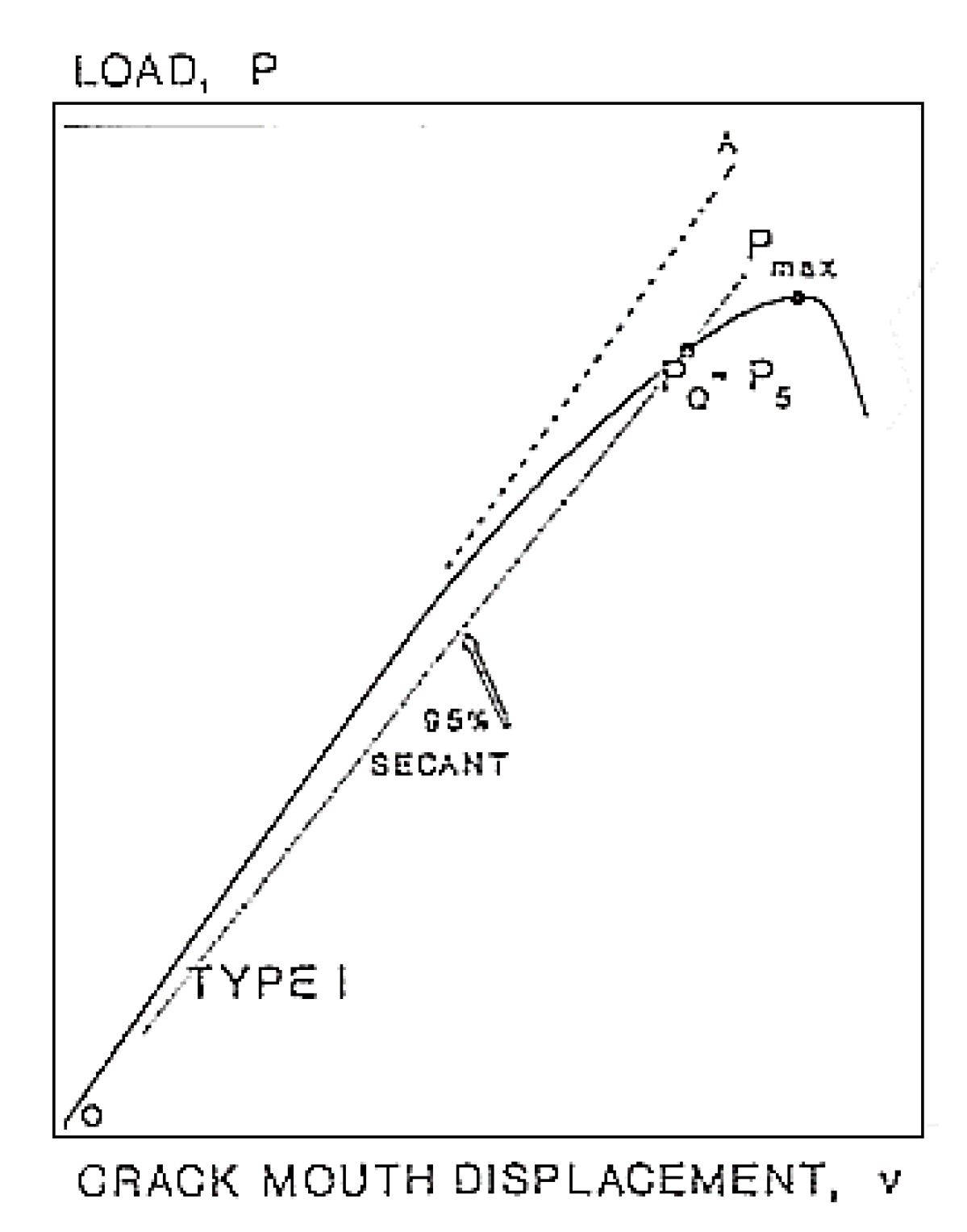

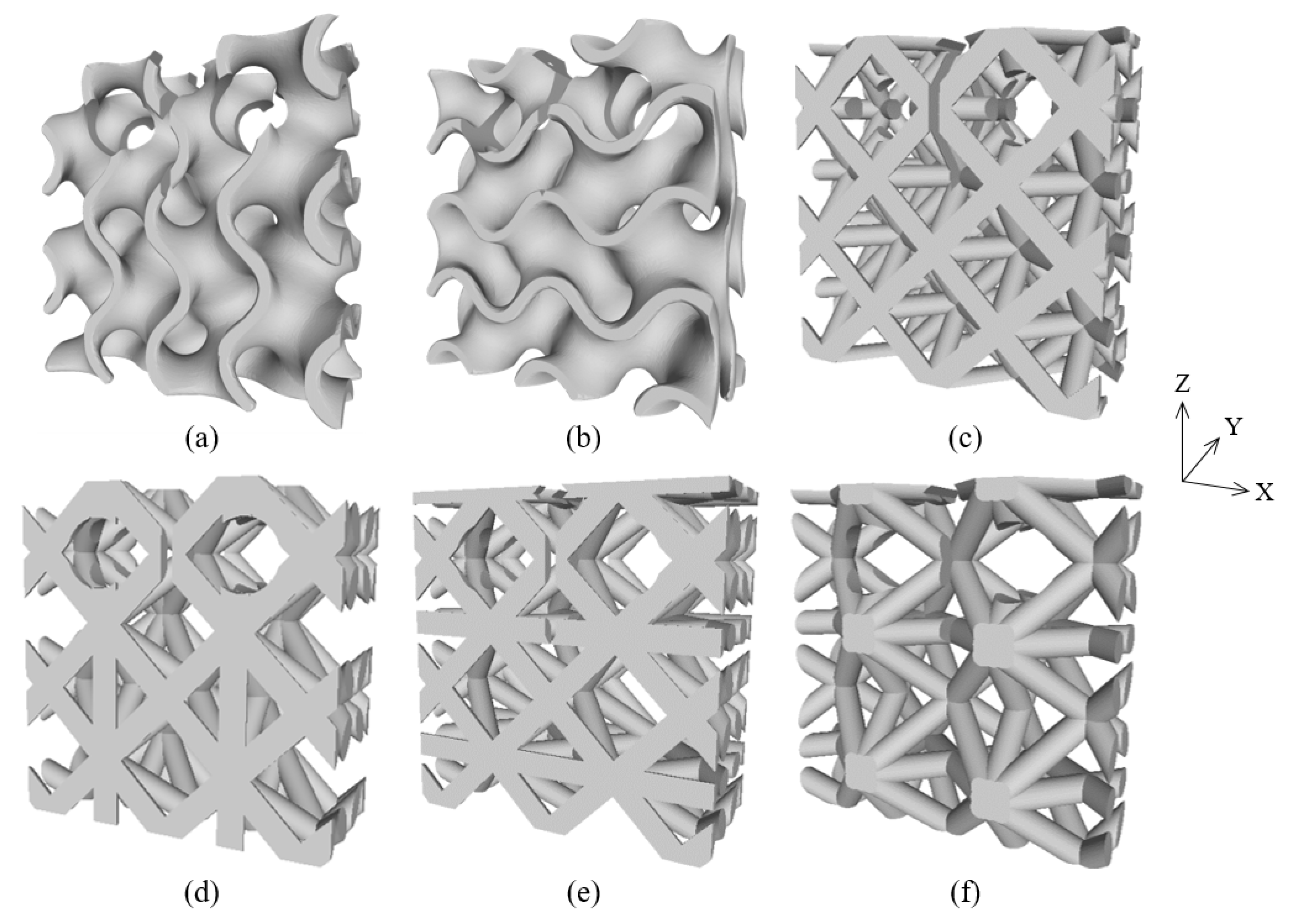
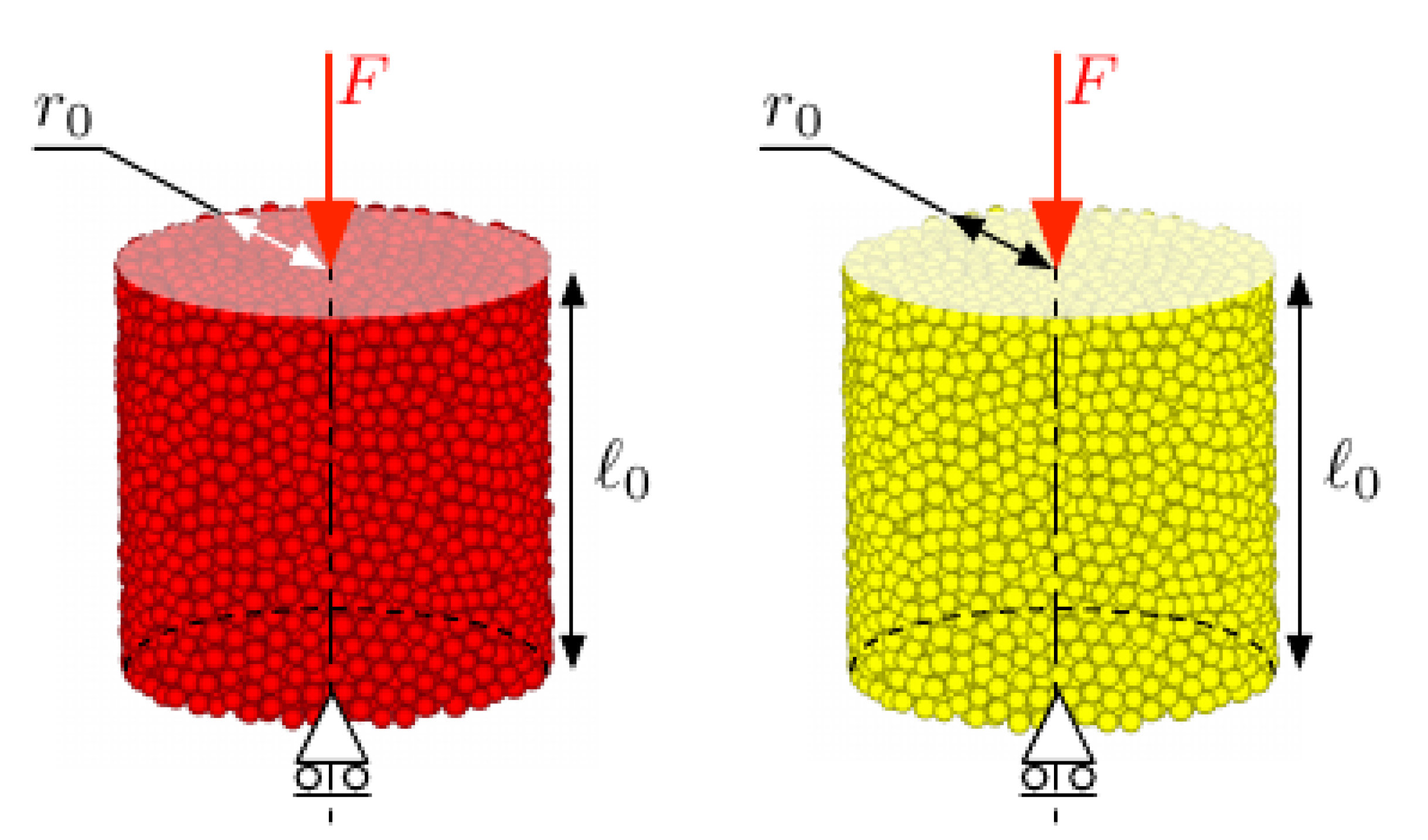
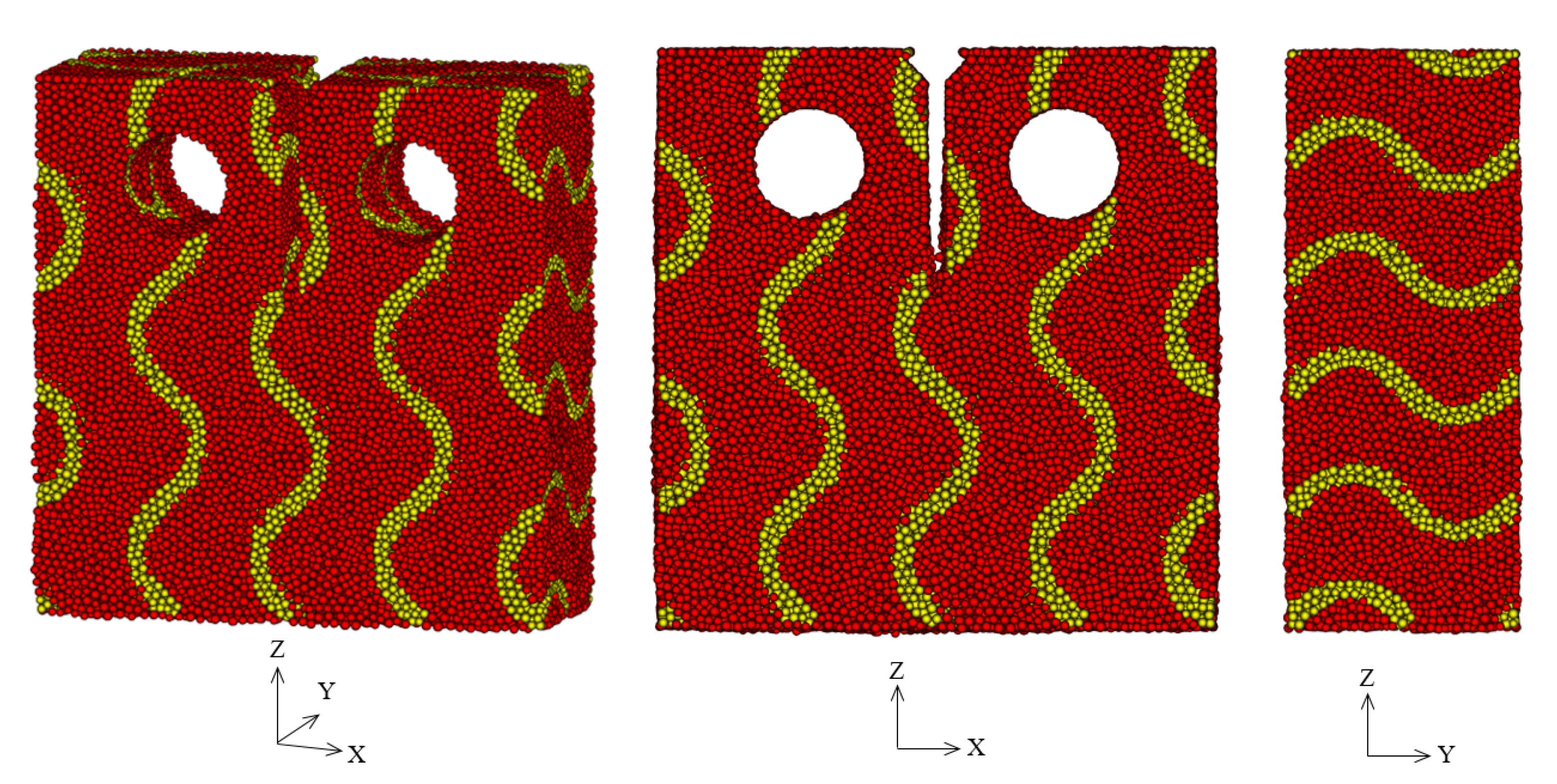

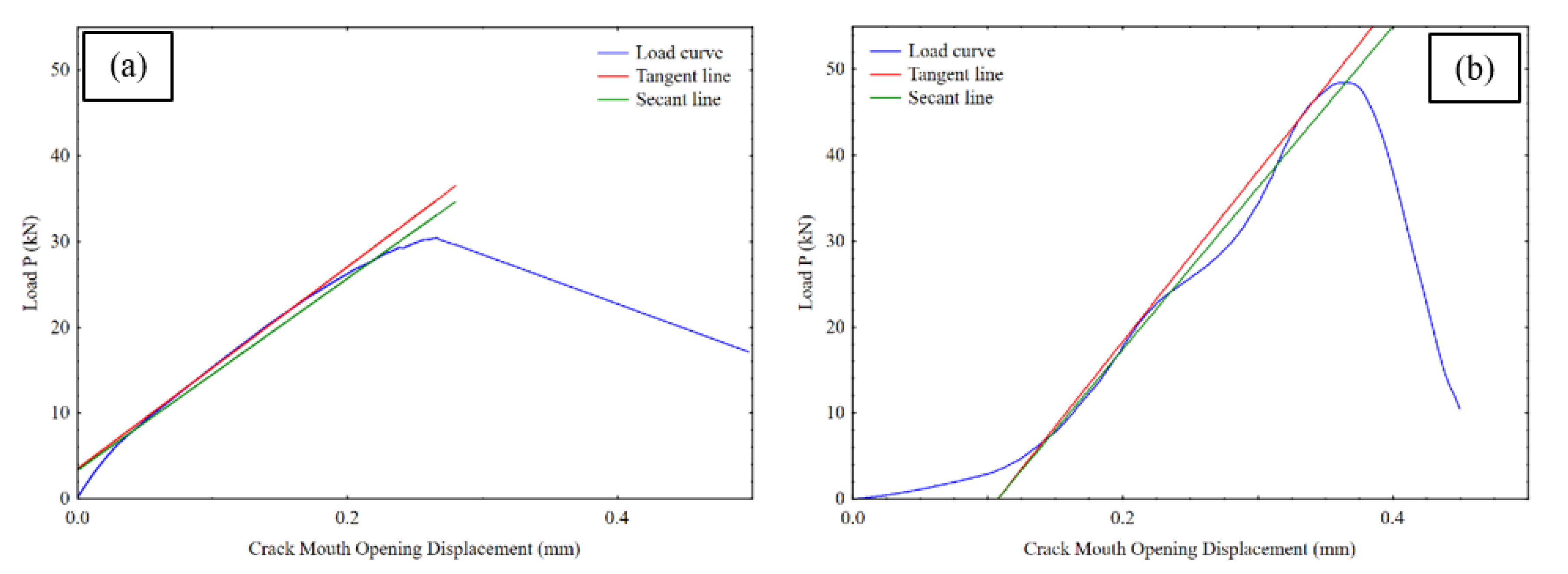
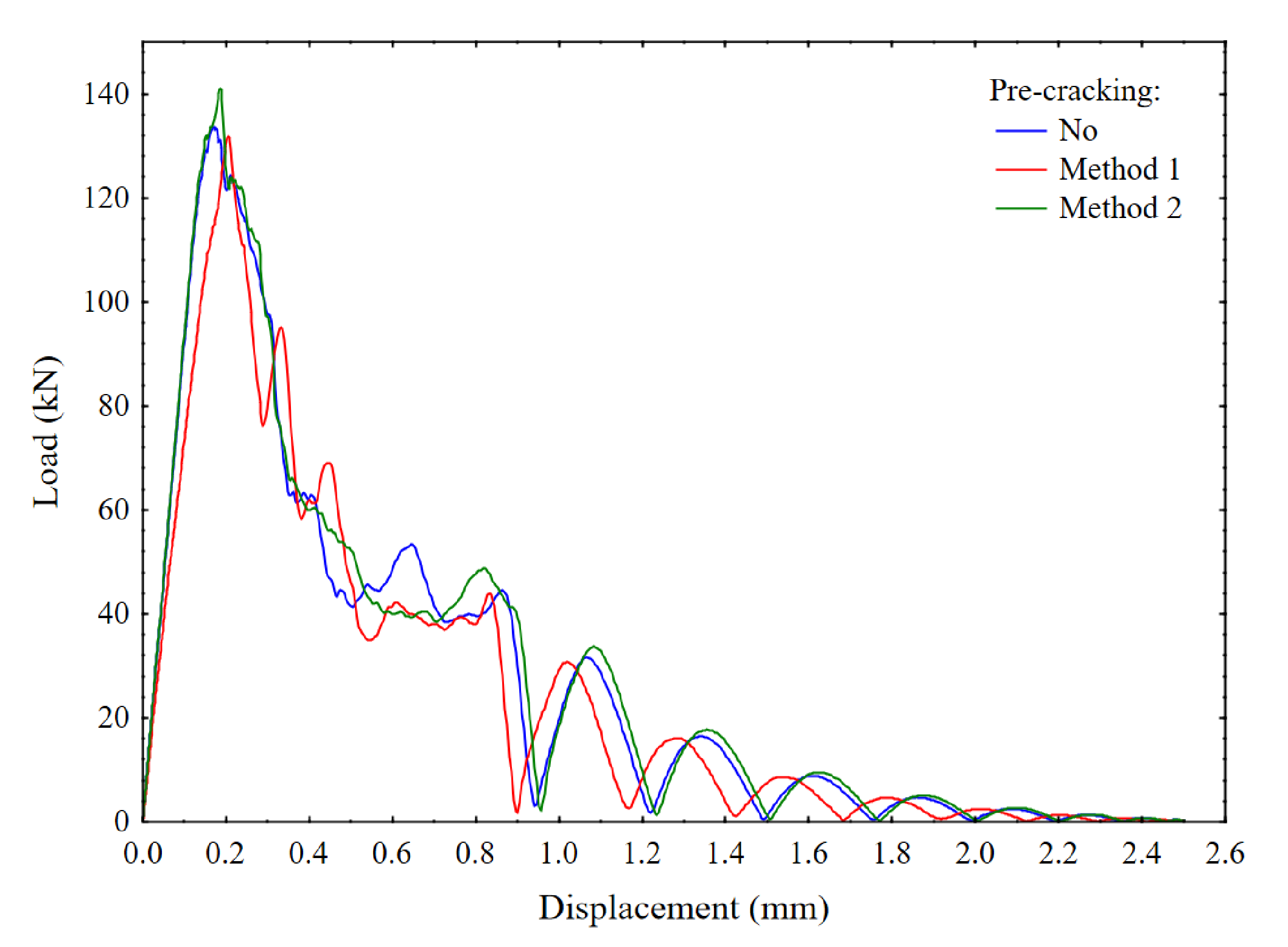
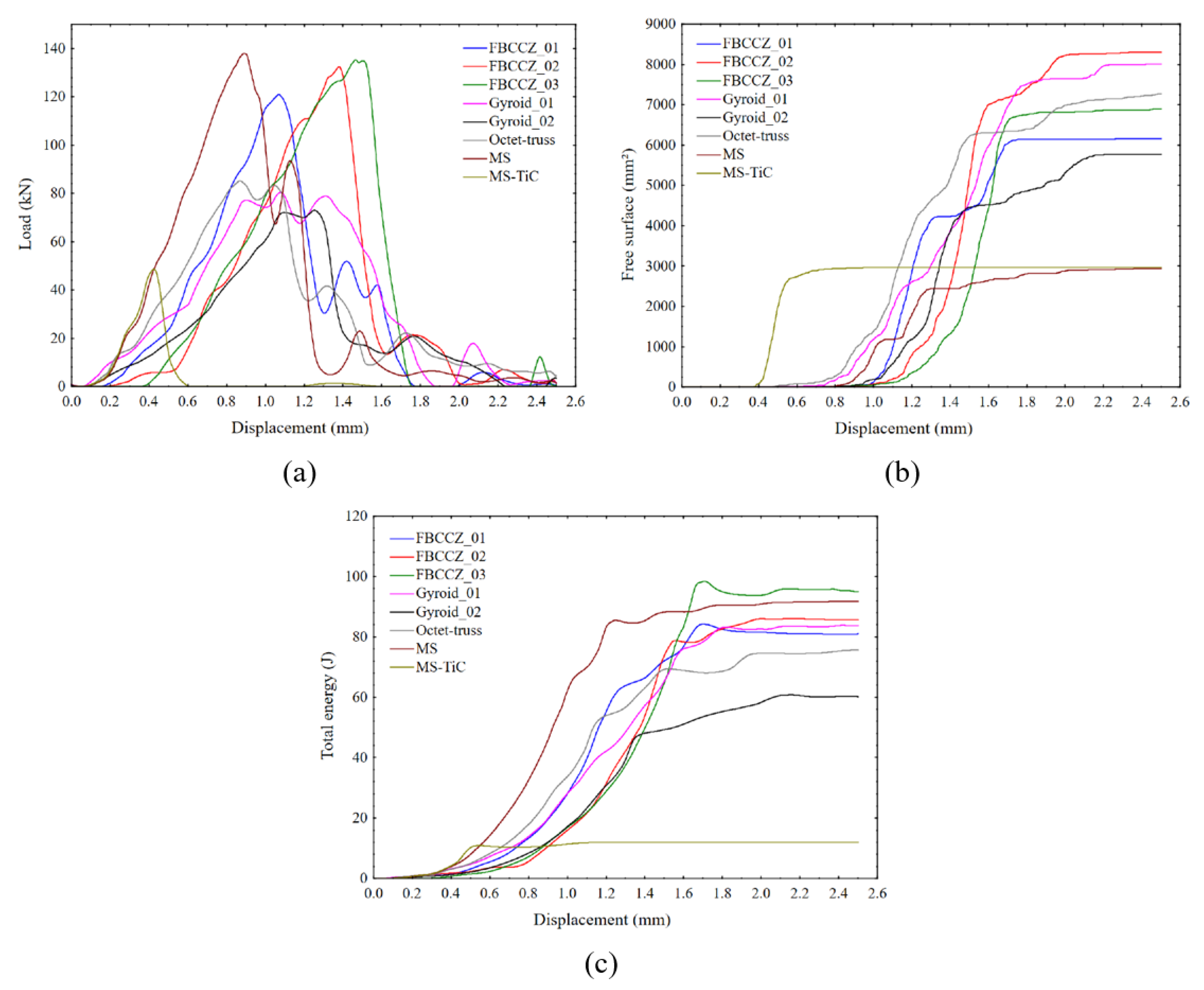
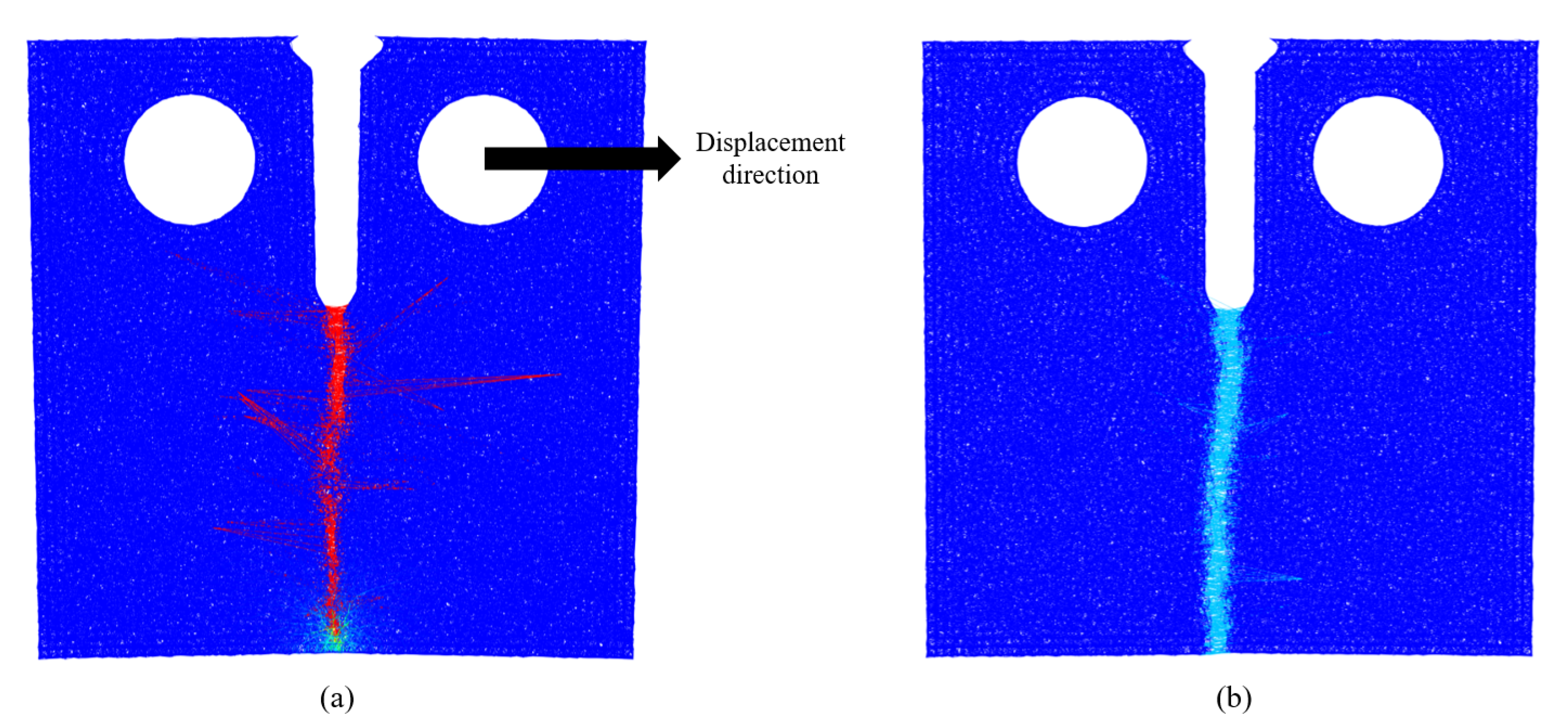
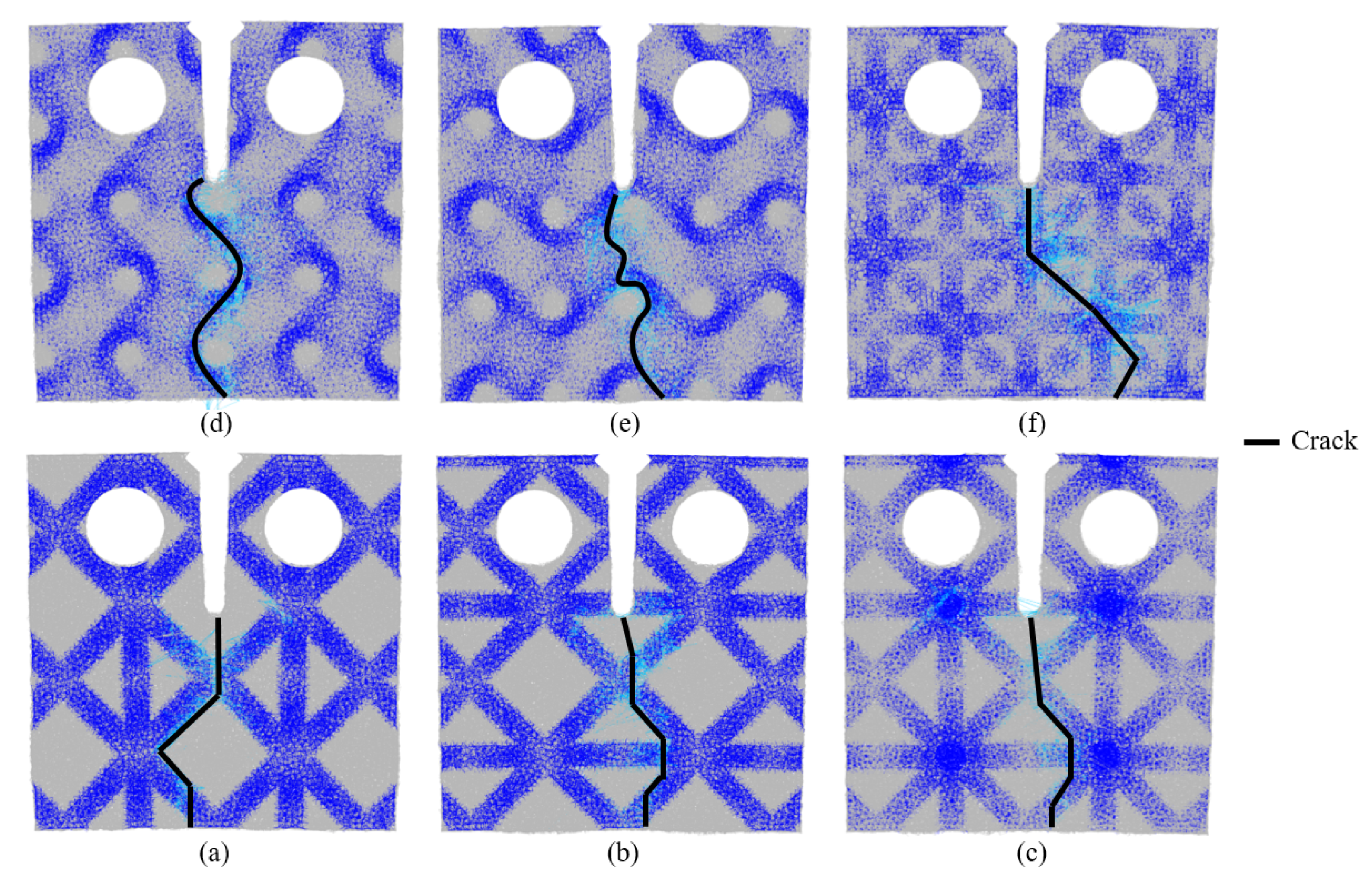


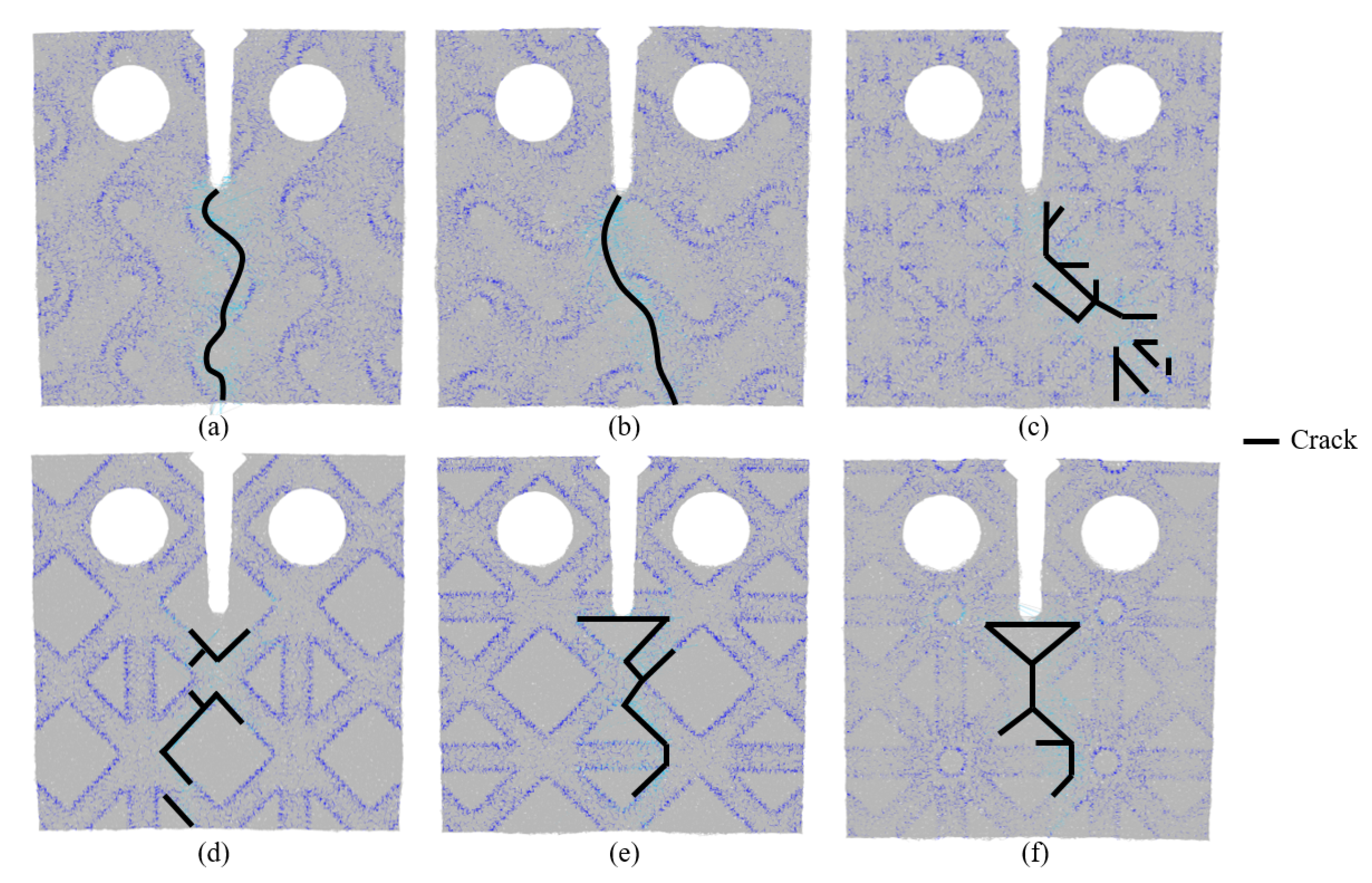
| Test Method | MS | MS-TiC | |
|---|---|---|---|
| Young’s modulus () | Impulsive excitation (ASTM C1259 [31]) | 203 | 230 |
| Poisson’s ratio | Impulsive excitation (ASTM C1259 [31]) | 0.29 | 0.26 |
| Strength () | Tensile (steel) / Three-points bending (MMC) | 1560 | 538 |
| Fracture toughness () | Pre-cracked CT (ASTM E399 [16]) | 105 | 35 |
| MS | MS-TiC | |
|---|---|---|
| Elastic modulus of the bonds (, ) | 5053 | 3098 |
| Radius ratio of the bonds (, no unit) | 0.34 | 0.43 |
| Failure stress of the bonds (, ) | 31.85 | 6.24 |
| Topology | Load for Crack | Free Surface | Total Absorbed | Energy per Unit | |
|---|---|---|---|---|---|
| Opening (N) | (mm2) | Energy (J) | Area (KJ m−2) | ||
| MS-TiC/MS | Gyroid_01 | 80,471 | 8011 | 84 | 66 |
| Gyroid_02 | 73,032 | 5773 | 60 | 48 | |
| Octet-truss | 85,269 | 7278 | 76 | 60 | |
| FBCCZ_01 | 121,081 | 6157 | 81 | 64 | |
| FBCCZ_02 | 132,487 | 8298 | 86 | 68 | |
| FBCCZ_03 | 135,374 | 6897 | 95 | 75 | |
| MS-TiC | no structure | 48,450 | 2963 | 12 | 10 |
| MS | no structure | 138,035 | 2940 | 92 | 73 |
© 2020 by the authors. Licensee MDPI, Basel, Switzerland. This article is an open access article distributed under the terms and conditions of the Creative Commons Attribution (CC BY) license (http://creativecommons.org/licenses/by/4.0/).
Share and Cite
Lemesle, J.; Hubert, C.; Bigerelle, M. Numerical Study of the Toughness of Complex Metal Matrix Composite Topologies. Appl. Sci. 2020, 10, 6250. https://doi.org/10.3390/app10186250
Lemesle J, Hubert C, Bigerelle M. Numerical Study of the Toughness of Complex Metal Matrix Composite Topologies. Applied Sciences. 2020; 10(18):6250. https://doi.org/10.3390/app10186250
Chicago/Turabian StyleLemesle, Julie, Cedric Hubert, and Maxence Bigerelle. 2020. "Numerical Study of the Toughness of Complex Metal Matrix Composite Topologies" Applied Sciences 10, no. 18: 6250. https://doi.org/10.3390/app10186250






